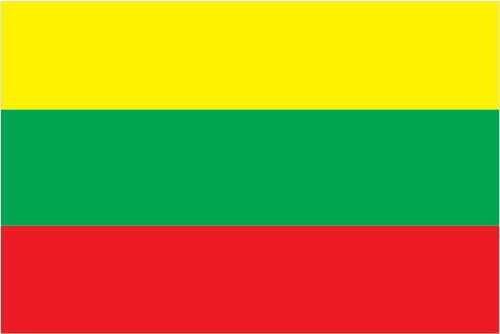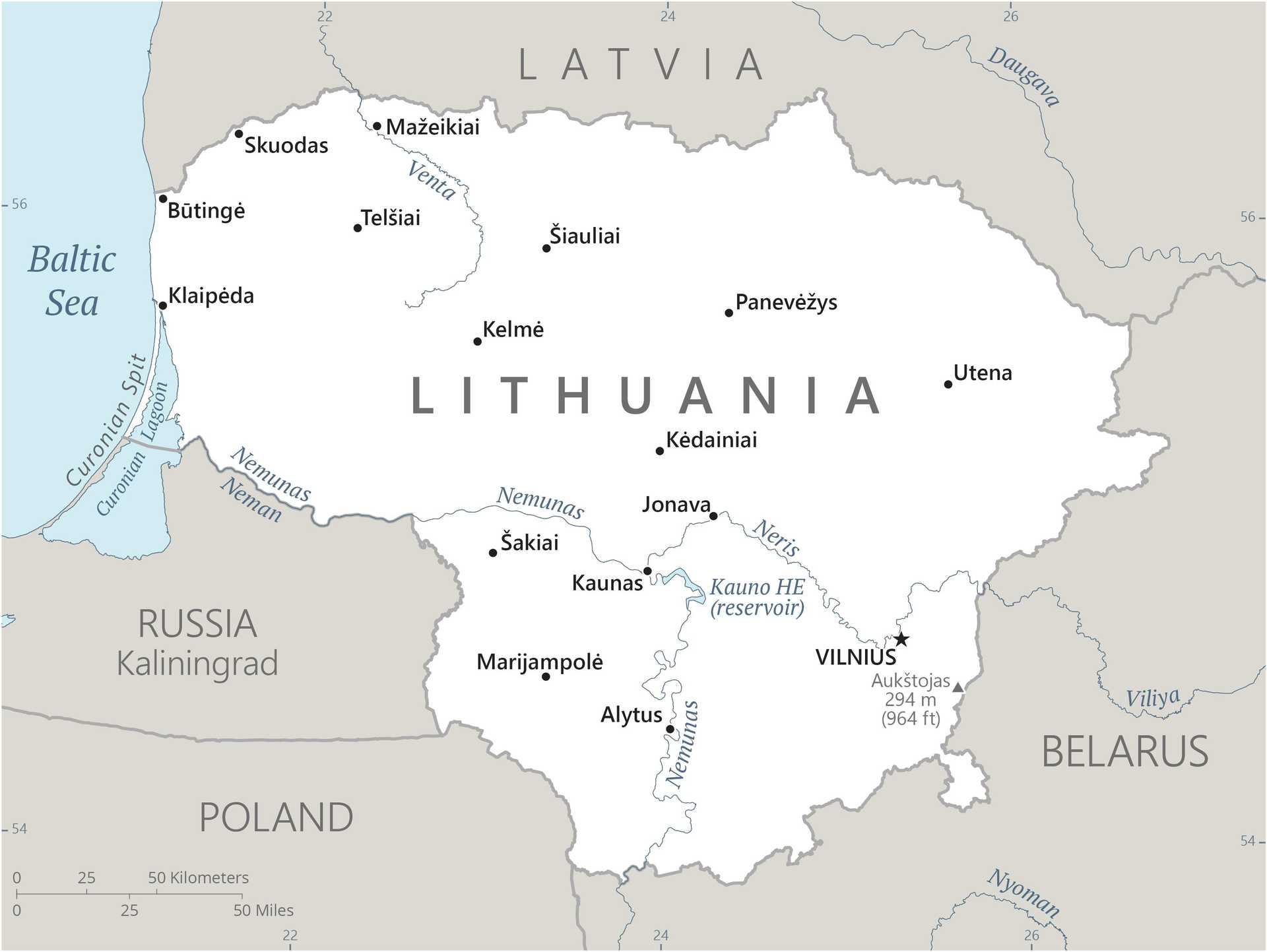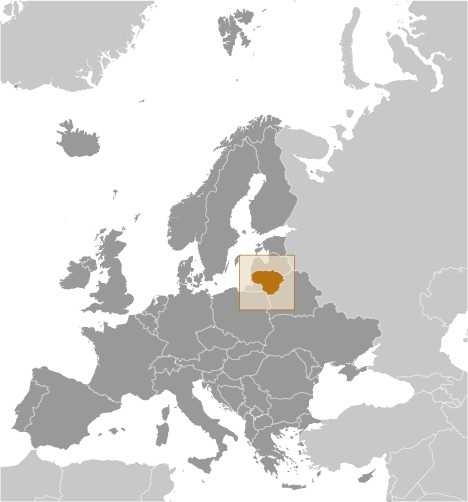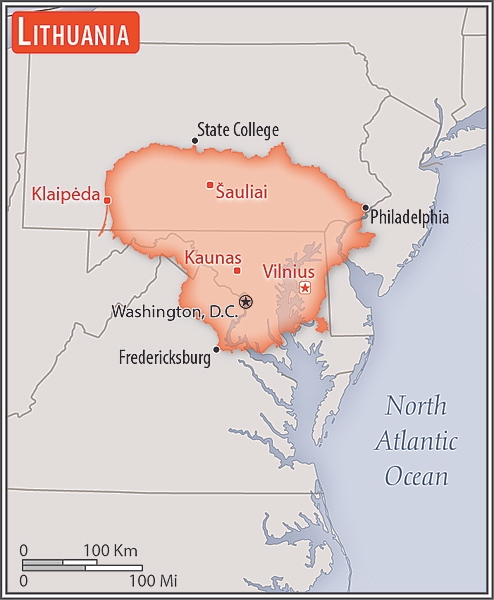Introduction
Background
Lithuanian lands were united under MINDAUGAS in 1236; over the next century, Lithuania extended its territory through alliances and conquest to include most of present-day Belarus and Ukraine. By the end of the 14th century, Lithuania was the largest state in Europe. An alliance with Poland in 1386 led the two countries into a union through a common ruler. In 1569, Lithuania and Poland formally united into a single dual state, the Polish-Lithuanian Commonwealth. This entity survived until 1795 when surrounding countries partitioned its remnants. Lithuania regained its independence after World War I, but the USSR annexed it in 1940 -- an action never recognized by the US and many other countries. In 1990, Lithuania became the first of the Soviet republics to declare its independence, but Moscow did not recognize this proclamation until 1991. The last Russian troops withdrew in 1993. Lithuania subsequently restructured its economy for integration into West European institutions; it joined both NATO and the EU in 2004. In 2015, Lithuania joined the euro zone, and it joined the Organization for Economic Cooperation and Development in 2018.
Visit the Definitions and Notes page to view a description of each topic.
Geography
Location
Eastern Europe, bordering the Baltic Sea, between Latvia and Russia, west of Belarus
Geographic coordinates
56 00 N, 24 00 E
Map references
Europe
Land boundaries
total: 1,545 km
border countries (4): Belarus 640 km; Latvia 544 km; Poland 100 km; Russia (Kaliningrad) 261 km
Coastline
90 km
Maritime claims
territorial sea: 12 nm
Climate
transitional, between maritime and continental; wet, moderate winters and summers
Terrain
lowland, many scattered small lakes, fertile soil
Elevation
highest point: Aukstojas 294 m
lowest point: Baltic Sea 0 m
mean elevation: 110 m
Natural resources
peat, arable land, amber
Land use
agricultural land: 44.8% (2018 est.)
arable land: 34.9% (2018 est.)
permanent crops: 0.5% (2018 est.)
permanent pasture: 9.4% (2018 est.)
forest: 34.6% (2018 est.)
other: 20.6% (2018 est.)
Irrigated land
16 sq km (2013)
Major lakes (area sq km)
salt water lake(s): Curonian Lagoon (shared with Russia) - 1,620 sq km
Population distribution
fairly even population distribution throughout the country, but somewhat greater concentrations in the southern cities of Vilnius and Kaunas, and the western port of Klaipeda
Natural hazards
occasional floods, droughts
Geography - note
fertile central plains are separated by hilly uplands that are ancient glacial deposits
People and Society
Population
total: 2,628,186
male: 1,214,994
female: 1,413,192 (2024 est.)
comparison rankings: female 141; male 145; total 142
Nationality
noun: Lithuanian(s)
adjective: Lithuanian
Ethnic groups
Lithuanian 84.6%, Polish 6.5%, Russian 5%, Belarusian 1%, other 1.1%, unspecified 1.8% (2021 est.)
Languages
Lithuanian (official) 85.3%, Russian 6.8%, Polish 5.1%, other 1.1%, two mother tongues 1.7% (2021 est.)
major-language sample(s):
Pasaulio enciklopedija – naudingas bendrosios informacijos šaltinis. (Lithuanian)
The World Factbook, the indispensable source for basic information.
Religions
Roman Catholic 74.2%, Russian Orthodox 3.7%, Old Believer 0.6%, Evangelical Lutheran 0.6%, Evangelical Reformist 0.2%, other (including Sunni Muslim, Jewish, Greek Catholic, and Karaite) 0.9%, none 6.1%, unspecified 13.7% (2021 est.)
Age structure
0-14 years: 15.2% (male 205,154/female 194,386)
15-64 years: 62.6% (male 808,435/female 837,908)
65 years and over: 22.2% (2024 est.) (male 201,405/female 380,898)
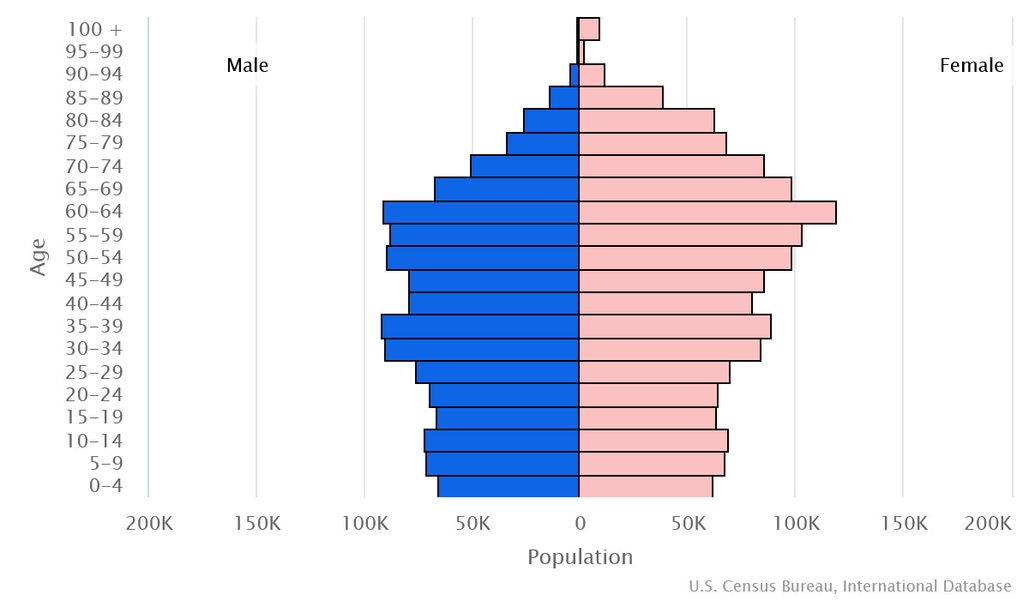
Dependency ratios
total dependency ratio: 55.7
youth dependency ratio: 23.6
elderly dependency ratio: 32.1
potential support ratio: 3.1 (2021 est.)
Median age
total: 45.1 years (2024 est.)
male: 40.9 years
female: 49.2 years
comparison ranking: total 18
Population distribution
fairly even population distribution throughout the country, but somewhat greater concentrations in the southern cities of Vilnius and Kaunas, and the western port of Klaipeda
Urbanization
urban population: 68.7% of total population (2023)
rate of urbanization: -0.12% annual rate of change (2020-25 est.)
Major urban areas - population
541,000 VILNIUS (capital) (2023)
Sex ratio
at birth: 1.06 male(s)/female
0-14 years: 1.06 male(s)/female
15-64 years: 0.96 male(s)/female
65 years and over: 0.53 male(s)/female
total population: 0.86 male(s)/female (2024 est.)
Mother's mean age at first birth
28.2 years (2020 est.)
Infant mortality rate
total: 3.6 deaths/1,000 live births (2024 est.)
male: 4 deaths/1,000 live births
female: 3.1 deaths/1,000 live births
comparison ranking: total 193
Life expectancy at birth
total population: 76.1 years (2024 est.)
male: 70.8 years
female: 81.7 years
comparison ranking: total population 117
Gross reproduction rate
0.79 (2024 est.)
Drinking water source
improved: urban: 100% of population
rural: 93.8% of population
total: 98% of population
unimproved: urban: 0% of population
rural: 6.2% of population
total: 2% of population (2020 est.)
Current health expenditure
7.5% of GDP (2020)
Physician density
5.08 physicians/1,000 population (2020)
Hospital bed density
6.4 beds/1,000 population (2018)
Sanitation facility access
improved: urban: 99.5% of population
rural: 88.7% of population
total: 96% of population
unimproved: urban: 0.5% of population
rural: 11.3% of population
total: 4% of population (2020 est.)
Major infectious diseases
degree of risk: intermediate (2023)
vectorborne diseases: tickborne encephalitis
Alcohol consumption per capita
total: 11.93 liters of pure alcohol (2019 est.)
beer: 4.61 liters of pure alcohol (2019 est.)
wine: 0.88 liters of pure alcohol (2019 est.)
spirits: 4.96 liters of pure alcohol (2019 est.)
other alcohols: 1.48 liters of pure alcohol (2019 est.)
comparison ranking: total 4
Tobacco use
total: 32% (2020 est.)
male: 42.1% (2020 est.)
female: 21.8% (2020 est.)
comparison ranking: total 20
Currently married women (ages 15-49)
53.4% (2023 est.)
Child marriage
women married by age 18: 0.3% (2021 est.)
Literacy
definition: age 15 and over can read and write
total population: 99.8%
male: 99.8%
female: 99.8% (2021)
School life expectancy (primary to tertiary education)
total: 16 years
male: 16 years
female: 17 years (2020)
Environment
Environment - current issues
water pollution; air pollution; deforestation; threatened animal and plant species; chemicals and waste materials released into the environment contaminate soil and groundwater; soil degradation and erosion
Environment - international agreements
party to: Air Pollution, Air Pollution-Heavy Metals, Air Pollution-Multi-effect Protocol, Air Pollution-Nitrogen Oxides, Air Pollution-Persistent Organic Pollutants, Air Pollution-Sulphur 85, Air Pollution-Sulphur 94, Air Pollution-Volatile Organic Compounds, Biodiversity, Climate Change, Climate Change-Kyoto Protocol, Climate Change-Paris Agreement, Comprehensive Nuclear Test Ban, Desertification, Endangered Species, Environmental Modification, Hazardous Wastes, Law of the Sea, Ozone Layer Protection, Ship Pollution, Tropical Timber 2006, Wetlands, Whaling
signed, but not ratified: none of the selected agreements
Climate
transitional, between maritime and continental; wet, moderate winters and summers
Land use
agricultural land: 44.8% (2018 est.)
arable land: 34.9% (2018 est.)
permanent crops: 0.5% (2018 est.)
permanent pasture: 9.4% (2018 est.)
forest: 34.6% (2018 est.)
other: 20.6% (2018 est.)
Urbanization
urban population: 68.7% of total population (2023)
rate of urbanization: -0.12% annual rate of change (2020-25 est.)
Air pollutants
particulate matter emissions: 10.37 micrograms per cubic meter (2019 est.)
carbon dioxide emissions: 12.96 megatons (2016 est.)
methane emissions: 3.15 megatons (2020 est.)
Waste and recycling
municipal solid waste generated annually: 1.3 million tons (2015 est.)
municipal solid waste recycled annually: 297,960 tons (2015 est.)
percent of municipal solid waste recycled: 22.9% (2015 est.)
Major lakes (area sq km)
salt water lake(s): Curonian Lagoon (shared with Russia) - 1,620 sq km
Total water withdrawal
municipal: 140 million cubic meters (2020 est.)
industrial: 60 million cubic meters (2020 est.)
agricultural: 60 million cubic meters (2020 est.)
Total renewable water resources
24.5 billion cubic meters (2020 est.)
Government
Country name
conventional long form: Republic of Lithuania
conventional short form: Lithuania
local long form: Lietuvos Respublika
local short form: Lietuva
former: Lithuanian Soviet Socialist Republic (while occupied by the USSR)
etymology: meaning of the name "Lietuva" remains unclear and is debated by scholars; it may derive from the Lietava, a stream in east central Lithuania
Government type
semi-presidential republic
Capital
name: Vilnius
geographic coordinates: 54 41 N, 25 19 E
time difference: UTC+2 (7 hours ahead of Washington, DC, during Standard Time)
daylight saving time: +1hr, begins last Sunday in March; ends last Sunday in October
etymology: named after the Vilnia River, which flows into the Neris River at Vilnius; the river name derives from the Lithuanian word "vilnis" meaning "a surge"
Administrative divisions
60 municipalities (savivaldybe, singular - savivaldybe); Akmene, Alytaus Miestas, Alytus, Anksciai, Birstonas, Birzai, Druskininkai, Elektrenai, Ignalina, Jonava, Joniskis, Jurbarkas, Kaisiadorys, Kalvarija, Kauno Miestas, Kaunas, Kazlu Rudos, Kedainiai, Kelme, Klaipedos Miestas, Klaipeda, Kretinga, Kupiskis, Lazdijai, Marijampole, Mazeikiai, Moletai, Neringa, Pagegiai, Pakruojis, Palangos Miestas, Panevezio Miestas, Panevezys, Pasvalys, Plunge, Prienai, Radviliskis, Raseiniai, Rietavas, Rokiskis, Sakiai, Salcininkai, Siauliu Miestas, Siauliai, Silale, Silute, Sirvintos, Skuodas, Svencionys, Taurage, Telsiai, Trakai, Ukmerge, Utena, Varena, Vilkaviskis, Vilniaus Miestas, Vilnius, Visaginas, Zarasai
Independence
16 February 1918 (from Soviet Russia and Germany); 11 March 1990 (declared from the Soviet Union); 6 September 1991 (recognized by the Soviet Union); notable earlier dates: 6 July 1253 (coronation of MINDAUGAS, traditional founding date); 1 July 1569 (Polish-Lithuanian Commonwealth created)
National holiday
Independence Day (or National Day), 16 February (1918); note - 16 February 1918 was the date Lithuania established its statehood and its concomitant independence from Soviet Russia and Germany; 11 March 1990 was the date it declared the restoration of Lithuanian statehood and its concomitant independence from the Soviet Union
Constitution
history: several previous; latest adopted by referendum 25 October 1992, entered into force 2 November 1992
amendments: proposed by at least one fourth of all Parliament members or by petition of at least 300,000 voters; passage requires two-thirds majority vote of Parliament in each of two readings three months apart and a presidential signature; amendments to constitutional articles on national sovereignty and constitutional amendment procedure also require three-fourths voter approval in a referendum; amended many times, last in 2022
Legal system
civil law system; legislative acts can be appealed to the Constitutional Court
International law organization participation
accepts compulsory ICJ jurisdiction with reservations; accepts ICCt jurisdiction
Citizenship
citizenship by birth: no
citizenship by descent only: at least one parent must be a citizen of Lithuania
dual citizenship recognized: no
residency requirement for naturalization: 10 years
Suffrage
18 years of age; universal
Executive branch
chief of state: President Gitanas NAUSEDA (since 12 July 2019)
head of government: Prime Minister Ingrida SIMONYTE (since 24 November 2020)
cabinet: Council of Ministers nominated by the prime minister, appointed by the president, approved by Parliament
elections/appointments: president directly elected by absolute majority popular vote in 2 rounds if needed for a 5-year term (eligible for a second term); first round of the election held on 12 May 204 (runoff to be held on 12 May 2024); prime minister appointed by the president, approved by Parliament
election results:
2024: Gitanas NAUSEDA elected president in the second round; percent of vote -Gitanas NAUSEDA (independent) 74.6%, Ingrida SIMONYTE (independent) 24.4%
2019: Gitanas NAUSEDA elected president in second round; percent of vote - Gitanas NAUSEDA (independent) 66.7%, Ingrida SIMONYTE (independent) 33.3%
Legislative branch
description: unicameral Parliament or Seimas (141 seats; 71 members directly elected in single-seat constituencies by absolute majority vote and 70 directly elected in a single nationwide constituency by proportional representation vote; members serve 4-year terms)
elections: last held on 11 and 25 October 2020 (next to be held on 13 October 2024)
election results: percent of vote by party - NA; seats by party - TS-LKD 50, LVZS 32, LSDP 13, LRLS 13, LP 11, DP 10, LLRA-KSS 3, LSDDP 3, LT 1, LZP 1, independent 4; composition - men 99, women 41, percentage women 29.3%
Judicial branch
highest court(s): Supreme Court (consists of 37 judges); Constitutional Court (consists of 9 judges)
judge selection and term of office: Supreme Court judges nominated by the president and appointed by the Seimas; judges serve 5-year renewable terms; Constitutional Court judges appointed by the Seimas from nominations - 3 each by the president of the republic, the Seimas speaker, and the Supreme Court president; judges serve 9-year, nonrenewable terms; one-third of membership reconstituted every 3 years
subordinate courts: Court of Appeals; district and local courts
Political parties and leaders
Democrats for Lithuania [Saulius SKVERNELIS]
Electoral Action of Lithuanian Poles or LLRA [Valdemar TOMASEVSKI]
Freedom and Justice Party or LT [Remigijus ZEMAITAITIS] (formerly Lithuanian Freedom Union (Liberals))
Freedom Party or LP [Ausrine ARMONAITE]
Homeland Union-Lithuanian Christian Democrats or TS-LKD [Gabrielius LANDSBERGIS]
Labor Party or DP [Andrius MAZURONIS]
Lithuanian Center Party or LCP [Naglis PUTEIKIS]
Lithuanian Farmers and Greens Union or LVZS [Ramunas KARBAUSKIS]
Lithuanian Green Party or LZP [Remigijus LAPINSKAS]
Lithuanian Liberal Movement or LS or LRLS [Viktorija CMILYTE-NIELSEN]
Lithuanian List or LL [Darius KUOLYS]
Lithuanian Regions Party or LRP [Jonas PINSKUS] (formerly Lithuanian Social Democratic Labor Party or LSDDP)
Lithuanian Social Democratic Party or LSDP [Vilija BLINKEVICIUTE]
International organization participation
Australia Group, BA, BIS, CBSS, CD, CE, EAPC, EBRD, ECB, EIB, EU, FAO, IAEA, IBRD, ICAO, ICC (national committees), ICCt, ICRM, IDA, IFC, IFRCS, ILO, IMF, IMO, Interpol, IOC, IOM, IPU, ISO, ITU, ITUC (NGOs), MIGA, NATO, NIB, NSG, OAS (observer), OECD, OIF (observer), OPCW, OSCE, PCA, Schengen Convention, UN, UNCTAD, UNESCO, UNHRC, UNIDO, UNWTO, UPU, Wassenaar Arrangement, WCO, WHO, WIPO, WMO, WTO
Diplomatic representation in the US
chief of mission: Ambassador Audra PLEPYTĖ (since 7 July 2021)
chancery: 2622 16th Street NW, Washington, DC 20009
telephone: [1] (202) 234-5860
FAX: [1] (202) 328-0466
email address and website:
info@usa.mfa.lt
https://usa.mfa.lt/usa/en/
consulate(s) general: Chicago, Los Angeles, New York
Diplomatic representation from the US
chief of mission: Ambassador Kara C. McDONALD (since 26 January 2024)
embassy: Akmenu gatve 6, Vilnius, LT-03106
mailing address: 4510 Vilnius Place, Washington DC 20521-4510
telephone: [370] (5) 266-5500
FAX: [370] (5) 266-5510
email address and website:
consec@state.gov
https://lt.usembassy.gov/
Flag description
three equal horizontal bands of yellow (top), green, and red; yellow symbolizes golden fields, as well as the sun, light, and goodness; green represents the forests of the countryside, in addition to nature, freedom, and hope; red stands for courage and the blood spilled in defense of the homeland
National symbol(s)
mounted knight known as Vytis (the Chaser), white stork; national colors: yellow, green, red
National anthem
name: "Tautiska giesme" (The National Song)
lyrics/music: Vincas KUDIRKA
note: adopted 1918, restored 1990; written in 1898 while Lithuania was a part of Russia; banned during the Soviet occupation from 1940 to 1990
National heritage
total World Heritage Sites: 5 (all cultural)
selected World Heritage Site locales: Vilnius Historic Center; Curonian Spit; Kernavė Archaeological Site; Struve Geodetic Arc; Modernist Kaunas: Architecture of Optimism, 1919-1939
Economy
Economic overview
high-income EU and eurozone member, largest Baltic economy; growth stalled due to Ukraine war impact on energy, exports, and fiscal spending for defense and refugee support; rebound supported by EU fund-driven investments and reduced inflation; structural challenges include pension reform, labor market inefficiencies, health care, and education spending
Real GDP (purchasing power parity)
$132.712 billion (2023 est.)
$133.159 billion (2022 est.)
$129.987 billion (2021 est.)
note: data in 2021 dollars
comparison ranking: 91
Real GDP growth rate
-0.34% (2023 est.)
2.44% (2022 est.)
6.28% (2021 est.)
note: annual GDP % growth based on constant local currency
comparison ranking: 195
Real GDP per capita
$46,200 (2023 est.)
$47,000 (2022 est.)
$46,400 (2021 est.)
note: data in 2021 dollars
comparison ranking: 54
GDP (official exchange rate)
$77.836 billion (2023 est.)
note: data in current dollars at official exchange rate
Inflation rate (consumer prices)
9.12% (2023 est.)
19.71% (2022 est.)
4.68% (2021 est.)
note: annual % change based on consumer prices
comparison ranking: 168
Credit ratings
Fitch rating: A (2020)
Moody's rating: A3 (2015)
Standard & Poors rating: A+ (2020)
note: The year refers to the year in which the current credit rating was first obtained.
GDP - composition, by sector of origin
agriculture: 3.5% (2017 est.)
industry: 29.4% (2017 est.)
services: 67.2% (2017 est.)
comparison rankings: services 86; industry 81; agriculture 146
GDP - composition, by end use
household consumption: 63.9% (2017 est.)
government consumption: 16.6% (2017 est.)
investment in fixed capital: 18.8% (2017 est.)
investment in inventories: -1.3% (2017 est.)
exports of goods and services: 81.6% (2017 est.)
imports of goods and services: -79.3% (2017 est.)
Agricultural products
wheat, milk, rapeseed, sugar beets, barley, potatoes, beans, triticale, oats, peas (2022)
note: top ten agricultural products based on tonnage
Industries
metal-cutting machine tools, electric motors, televisions, refrigerators and freezers, petroleum refining, shipbuilding (small ships), furniture, textiles, food processing, fertilizer, agricultural machinery, optical equipment, lasers, electronic components, computers, amber jewelry, information technology, video game development, app/software development, biotechnology
Industrial production growth rate
-2.17% (2023 est.)
note: annual % change in industrial value added based on constant local currency
comparison ranking: 184
Labor force
1.51 million (2023 est.)
note: number of people ages 15 or older who are employed or seeking work
comparison ranking: 134
Unemployment rate
6.96% (2023 est.)
5.96% (2022 est.)
7.11% (2021 est.)
note: % of labor force seeking employment
comparison ranking: 138
Youth unemployment rate (ages 15-24)
total: 19% (2021 est.)
male: 18.5%
female: 19.6%
comparison ranking: total 88
Population below poverty line
20.9% (2021 est.)
note: % of population with income below national poverty line
Gini Index coefficient - distribution of family income
36.7 (2021 est.)
note: index (0-100) of income distribution; higher values represent greater inequality
comparison ranking: 81
Average household expenditures
on food: 21% of household expenditures (2021 est.)
on alcohol and tobacco: 5.9% of household expenditures (2021 est.)
Household income or consumption by percentage share
lowest 10%: 2.6% (2021 est.)
highest 10%: 29.1% (2021 est.)
note: % share of income accruing to lowest and highest 10% of population
Remittances
1.25% of GDP (2023 est.)
1.04% of GDP (2022 est.)
1.16% of GDP (2021 est.)
note: personal transfers and compensation between resident and non-resident individuals/households/entities
Budget
revenues: $18.636 billion (2019 est.)
expenditures: $18.491 billion (2019 est.)
Public debt
36.05% of GDP (2022 est.)
48.21% of GDP (2021 est.)
52.86% of GDP (2020 est.)
note: central government debt as a % of GDP
comparison ranking: 147
Taxes and other revenues
21.1% (of GDP) (2022 est.)
note: central government tax revenue as a % of GDP
comparison ranking: 80
Current account balance
$1.506 billion (2023 est.)
-$3.874 billion (2022 est.)
$766.788 million (2021 est.)
note: balance of payments - net trade and primary/secondary income in current dollars
comparison ranking: 50
Exports
$61.101 billion (2023 est.)
$61.444 billion (2022 est.)
$53.397 billion (2021 est.)
note: balance of payments - exports of goods and services in current dollars
comparison ranking: 59
Exports - partners
Latvia 13%, Poland 8%, Germany 8%, Russia 6%, US 6% (2022)
note: top five export partners based on percentage share of exports
Exports - commodities
refined petroleum, furniture, plastic products, natural gas, wheat (2022)
note: top five export commodities based on value in dollars
Imports
$58.104 billion (2023 est.)
$62.853 billion (2022 est.)
$50.377 billion (2021 est.)
note: balance of payments - imports of goods and services in current dollars
comparison ranking: 63
Imports - partners
Poland 12%, Germany 11%, Latvia 8%, US 6%, Russia 5% (2022)
note: top five import partners based on percentage share of imports
Imports - commodities
crude petroleum, natural gas, electricity, cars, plastic products (2022)
note: top five import commodities based on value in dollars
Reserves of foreign exchange and gold
$6.168 billion (2023 est.)
$5.365 billion (2022 est.)
$5.58 billion (2021 est.)
note: holdings of gold (year-end prices)/foreign exchange/special drawing rights in current dollars
comparison ranking: 98
Exchange rates
euros (EUR) per US dollar -
Exchange rates:
0.925 (2023 est.)
0.95 (2022 est.)
0.845 (2021 est.)
0.876 (2020 est.)
0.893 (2019 est.)
Energy
Electricity access
electrification - total population: 100% (2022 est.)
Electricity
installed generating capacity: 4.258 million kW (2022 est.)
consumption: 11.227 billion kWh (2022 est.)
exports: 2.652 billion kWh (2022 est.)
imports: 11.22 billion kWh (2022 est.)
transmission/distribution losses: 855.476 million kWh (2022 est.)
comparison rankings: transmission/distribution losses 91; imports 24; exports 51; consumption 98; installed generating capacity 95
Electricity generation sources
fossil fuels: 28.1% of total installed capacity (2022 est.)
solar: 4.7% of total installed capacity (2022 est.)
wind: 42.8% of total installed capacity (2022 est.)
hydroelectricity: 6.6% of total installed capacity (2022 est.)
biomass and waste: 17.8% of total installed capacity (2022 est.)
Nuclear energy
Number of nuclear reactors permanently shut down: 2 (2023)
Coal
consumption: 263,000 metric tons (2022 est.)
exports: 154,000 metric tons (2022 est.)
imports: 496,000 metric tons (2022 est.)
Petroleum
total petroleum production: 4,000 bbl/day (2023 est.)
refined petroleum consumption: 68,000 bbl/day (2023 est.)
crude oil estimated reserves: 12 million barrels (2021 est.)
Natural gas
consumption: 1.601 billion cubic meters (2022 est.)
exports: 1.921 billion cubic meters (2022 est.)
imports: 3.53 billion cubic meters (2022 est.)
Carbon dioxide emissions
12.803 million metric tonnes of CO2 (2022 est.)
from coal and metallurgical coke: 586,000 metric tonnes of CO2 (2022 est.)
from petroleum and other liquids: 9.115 million metric tonnes of CO2 (2022 est.)
from consumed natural gas: 3.102 million metric tonnes of CO2 (2022 est.)
comparison ranking: total emissions 100
Communications
Telephones - fixed lines
total subscriptions: 250,000 (2022 est.)
subscriptions per 100 inhabitants: 9 (2022 est.)
comparison ranking: total subscriptions 117
Telephones - mobile cellular
total subscriptions: 3.826 million (2022 est.)
subscriptions per 100 inhabitants: 139 (2022 est.)
comparison ranking: total subscriptions 136
Telecommunication systems
general assessment:
Lithuania’s small telecoms market is among the more advanced in Europe, particularly given the universal access to long-term evolution (LTE) infrastructure and the extensive fiber footprint; Operator investment has been focused on fiber broadband and mobile network upgrades; Fiber is now by far the dominant fixed broadband platform, with the number of Digital Subscriber Line (DSL) and cable connections in steady decline; LTE services are available nationally, operators have made steady investments in 5G
(2024)domestic: nearly 9 per 100 for fixed-line subscriptions; mobile-cellular subscriptions at 139 per 100 persons (2022)
international: country code - 370; landing points for the BCS East, BCS East-West Interlink and NordBalt connecting Lithuania to Sweden, and Latvia ; further transmission by satellite; landline connections to Latvia and Poland (2019)
Broadcast media
public broadcaster operates 3 channels with the third channel - a satellite channel - introduced in 2007; various privately owned commercial TV broadcasters operate national and multiple regional channels; many privately owned local TV stations; multi-channel cable and satellite TV services available; publicly owned broadcaster operates 3 radio networks; many privately owned commercial broadcasters, with repeater stations in various regions throughout the country
Internet users
total: 2.436 million (2021 est.)
percent of population: 87% (2021 est.)
comparison ranking: total 130
Broadband - fixed subscriptions
total: 796,814 (2020 est.)
subscriptions per 100 inhabitants: 29 (2020 est.)
comparison ranking: total 77
Transportation
National air transport system
number of registered air carriers: 3 (2020)
inventory of registered aircraft operated by air carriers: 50
annual passenger traffic on registered air carriers: 26,031 (2018)
Heliports
2 (2024)
Pipelines
1,921 km gas, 121 km refined products (2013)
Merchant marine
total: 59 (2023)
by type: container ship 3, general cargo 19, oil tanker 2, other 35
comparison ranking: total 114
Ports
total ports: 2 (2024)
large: 0
medium: 1
small: 0
very small: 1
ports with oil terminals: 2
key ports: Butinge Oil Terminal, Klaipeda
Military and Security
Military and security forces
Lithuanian Armed Forces (Lietuvos Ginkluotosios Pajegos): Land Forces (Sausumos Pajegos), Naval Forces (Karines Juru Pajegos), Air Forces (Karines Oro Pajegos), Special Operations Forces (Specialiuju Operaciju Pajegos); National Defense Volunteer Forces (Krašto Apsaugos Savanorių Pajegos or KASP); National Riflemen's Union (Lietuvos šaulių sąjunga) (2024)
note 1: the National Rifleman's Union is a civilian paramilitary organization supported by the Lithuanian Government that cooperates with the military but is not part of it; however, in a state of war, its armed formations would fall under the armed forces
note 2: the Lithuanian Police and State Border Guard Service are under the Ministry of Interior; in wartime, the State Border Guard Service becomes part of the armed forces
Military expenditures
2.9% of GDP (2024 est.)
2.8% of GDP (2023)
2.5% of GDP (2022)
2% of GDP (2021)
2.1% of GDP (2020)
comparison ranking: 36
Military and security service personnel strengths
approximately 18,000 active-duty personnel (14,000 Army, including about 5,000 active National Defense Voluntary Forces); 500 Navy; 1,000 Air Force; 2,500 other, including special operations forces, logistics support, training, etc) (2024)
Military equipment inventories and acquisitions
the military's inventory is a mix of Soviet-era and more modern European and US equipment; Germany and the US have been the leading suppliers in recent years (2023)
Military service age and obligation
19-26 years of age for conscripted military service for men; 9-month service obligation; in 2015, Lithuania reinstated conscription after having converted to a professional military in 2008; 18-38 for voluntary service for men and women (2024)
note 1: Lithuania conscripts up to 4,000 males each year; conscripts are selected using an automated lottery system
note 2: as of 2020, women comprised about 12% of the military's full-time personnel
Military deployments
note: contributes about 350-550 troops to the Lithuania, Poland, and Ukraine joint military brigade (LITPOLUKRBRIG), which was established in 2014; the brigade is headquartered in Poland and is comprised of an international staff, three battalions, and specialized units; units affiliated with the multinational brigade remain within the structures of the armed forces of their respective countries until the brigade is activated for participation in an international operation
Military - note
the Lithuanian Armed Forces are responsible for the defense of the country’s interests, sovereignty, and territory, fulfilling Lithuania’s commitments to NATO and European security, and contributing to UN international peacekeeping efforts; Russia is Lithuania’s primary security focus, which has only increased since the Russian seizure of Crimea in 2014 and subsequent full-scale attack on Ukraine in 2022; Lithuania has been a member of NATO since 2004 and is reliant on the Alliance as the country’s security guarantor; it is actively engaged in both NATO and EU security, as well as bilaterally with allies such as the other Baltic States, Germany, Poland, the UK, Ukraine, and the US; the Lithuanian military has participated in NATO and EU missions abroad and regularly conducts training and exercises with NATO and EU partner forces; it hosts NATO forces, is a member of the UK-led Joint Expeditionary Force, and contributes troops to a multinational brigade with Poland and Ukraine; Lithuania participated in its first UN peacekeeping mission in 1994
since 2017, Lithuania has hosted a German-led multinational NATO ground force battlegroup as part of the Alliance’s Enhanced Forward Presence initiative; NATO has also provided air protection for Lithuania since 2004 through its Baltic Air Policing mission; NATO member countries that possess air combat capabilities voluntarily contribute to the mission on four-month rotations; NATO fighter aircraft are hosted at Lithuania’s Šiauliai Air Base (2024)
Transnational Issues
Refugees and internally displaced persons
refugees (country of origin): 41,490 (Ukraine) (as of 11 March 2024)
stateless persons: 2,720 (2022)
Illicit drugs
source country for amphetamine tablets

